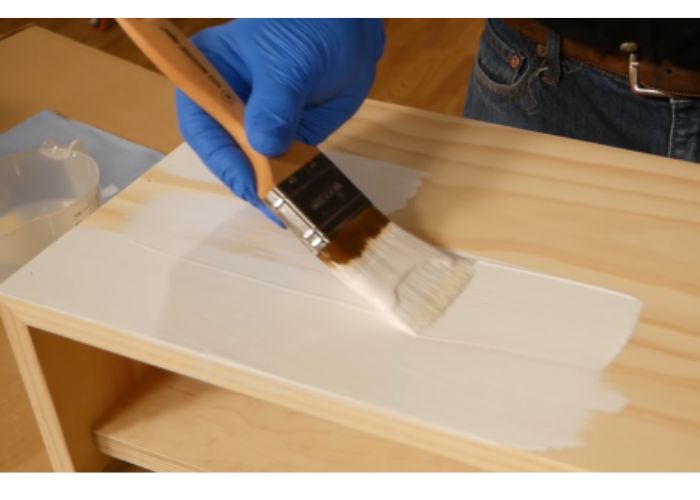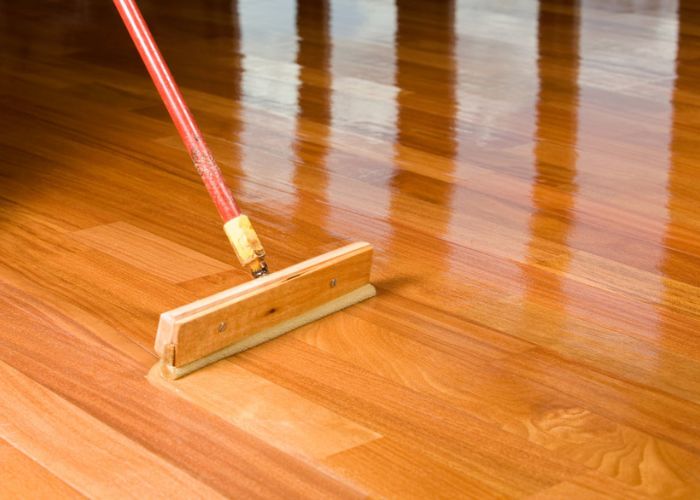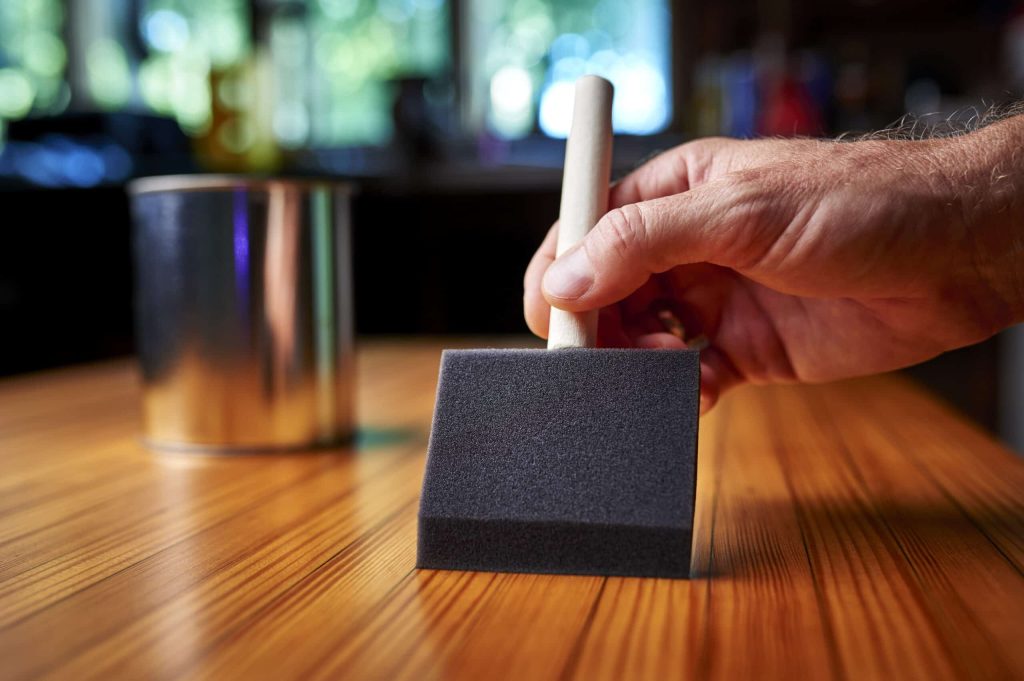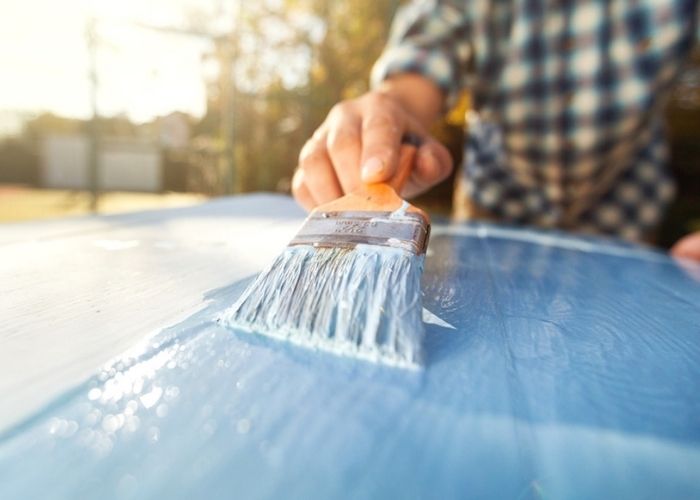It’s a question that comes up often – can you put polyurethane over chalk paint? What it boils down to is whether or not the finish has been “sealed.”
As you know, chalk paint is a type of paint that is made with pigment instead of the typical colorless acrylic or latex. On the other hand, polyurethane is a sealant that protects against moisture, scratches, and stains.
But can you use poly over chalk paint?
Well, before we answer the question, here’s an overview of the topics we’re going to cover;
- Can you put polyurethane over chalk paint
- How Long Should Chalk Painted Furniture Dry Before Applying Polyurethane?
- How Long Do Water and Oil Polyurethane On Paint Take To Dry
- How Long Does Polyurethane Take to Cure?
- Can You Speed Up Polyurethane Drying Time?
- How Many Coats of Chalk Paint Do You Need Before Applying Polyurethane?
- Can I Use a Roller for Chalk Paint and Polyurethane?
In short;
Can You Put Polyurethane Over Chalk Paint?
Yes, you can apply oil polyurethane over chalk paint. Polyurethane will leave your surface looking glossy, although not as shiny as other topcoats do. However, you might want to use a water-based formula for better results. Otherwise, your chalk-painted surface will begin to yellow and peel off after some time.
Read on for the full guide
How Long Should Chalk Paint Dry Before Applying Polyurethane?

Generally, it is always advisable to wait between 24 and 72 hours for chalk-painted furniture to dry well before applying Polyurethane.
Leave the surface for an even longer time for better results. The longer you wait, the more durable the surface will be.
Your waiting period will also depend on factors such as atmospheric conditions and ventilation. For example, if your ventilation is poor, you will have to wait for a little longer.
How Long Do Water and Oil Based Polyurethane On Chalk Paint Take To Dry
There’re two types of Poly you can put on paint;
- Water-based
- Oil-based
And their dry time on chalk paint, however, does differ.
1. How Long Does Water-Based Polyurethane On Chalk Paint Take To Dry?
Unlike oil-based Polyurethane, water-based dry quickly on chalk paint, but they are more watery. This implies you will need to apply more coats of even up to three layers, unlike oil-based.
When chalk painting furniture or floors, allow up to six hours for water-based poly to dry. Therefore, you should only walk barefooted on the surface until it dries well. Also, ensure your pets keep off the floor during this time.
Again it will take 48-72 hours for it to cure on chalk-painted furniture or floors. It can even take up to 30 days to cure completely. After this time, you can now put your rugs over the surface. For your mats, you might have to wait for two more weeks before putting them on your floor.
2. How Long Does Oil Polyurethane On Chalk Paint Take To Dry?
Oil-based Polyurethane can turn into a yellow or amber finish once you apply. It will form a thick and hard covering after some other few coats.
Just like latex paint, oil Poly also dries slowly. It takes about 24 hours to dry. However, at this time, you will still have to walk on the floor without shoes, and your pets kept off.
Additionally, they aren’t cured instantly. It takes about 30 days for it to cure completely.
How Long Does Polyurethane Take to Cure?

Let’s first understand the difference between drying and curing Polyurethane.
Polyurethane is considered “cured” when the constituent molecules have been wholly subjected to chemical interaction with oxygen.
This process allows molecules to bond. As a result, every polyurethane coat will bond with the last coat during curing. It takes up to 30 days for complete curing.
Polyurethane is considered “dry” when the surface no longer has a wet appearance. Therefore, a complete curing process of polyurethane finish on floors takes up to a month or so.
This also depends on prevailing environmental conditions such as temperatures and other factors such as the number of polyurethane coats and the thickness of the film.
Can You Speed Up Polyurethane Drying Time?
The answer to this is yes. But what do you do when polyurethane doesn’t dry?
Well, you will need to open up the doors and windows. You can, however, hasten the process by putting fans in the room to enhance faster air circulation.
Your room ventilation also plays a vital role in the evaporation process. You will realize the importance of proper ventilation when the fumes concentrate in the room, and maybe you are going on with your work in the next room. Poor ventilation will compromise your safety.
How Many Coats of Chalk Painted Furniture Do You Need Before Applying Polyurethane?
Several chalk paint coats will give outstanding coverage. For example, if you paint a white surface or a white surface on a dark piece, two coats or three will work perfectly.
Considering chalk paint’s drying speed, you will wait for some time before you apply the next layer.
How Long Should You Let Chalk Paint Dry Before Applying the Second Coat?
Most chalk paint manufacturers recommend you wait for at least 24 hours after the first coat and the subsequent paint coats.
The duration enhances product performance and gives enough time for the paint to dry up.
How Do You Get a Smooth Finish With Chalk Paints?
Most people allude that chalk paint can only create a distressed finish, which is untrue. Below are some of the few simple steps to give your surface a contemporary finish
- First, sand the surface to smooth out any prominent texture that might be present.
- Water down your paint and apply light coats in the same direction as the wood grain. Use the best brush for chalk paint so that you don’t have brush marks left behind.
- Using a brush or a lint-free cloth, apply a clear chalk paint wax. And remove any excess paint in the process.
Can I Use a Roller for Chalk Paint and Polyurethane?
Using a roller to apply your chalk paint causes no harm. The type of your project, however, will determine which other method to use. For example, if you are working on a large area, you might use a spray gun.
If you have resorted to the roller, make sure to roll thin coats of paint in a long unidirectional stroke. Then, repeat the process until you achieve a smooth matte finish in your entire project.
Here are the two top alternatives of Polyurethane topcoats.
Top Coat Alternatives for Polyurethane

Wax
Wax is one of the alternatives you can use instead of Polyurethane as it provides an excellent protective coat to wooden surfaces such as a dining room table.
It is a semi-solid paste that comes in different scents and colors. It gives your surface an elegant matte finish and protects your floor against tear and wear.
The part I like the most about wax is it repels water leaving your surface smooth even when it rains. In high traffic areas, however, you will need to reapply it consistently. This process consumes a lot of time.
Related posts:
Can you Put Polyurethane Over Wax?
Can you wax over polyurethane?
Polycrylic
Polycrylic has almost the same features as Polyurethane. The only difference is polyacrylic is water-based, unlike Polyurethane.
Considering the difference between polycrylic and polyurethane, Polycrylic is inherently more durable than Polyurethane and also offers easier workability. However, it isn’t as consistently available as Polyurethane. Additionally, when dealing with an unsealed painted surface, you’ll require multiple coats for a superior finish.
Danish oil
Danish oil enhances the appearance of wood surfaces. It’s a blend of oil and varnish, often with added resins and driers. And the good side is, you can put poly over Danish oil.
Danish oil penetrates the wood, bringing out its natural beauty and enhancing the grain pattern. It provides a rich, warm finish with a satin sheen, making it ideal for furniture, woodworking projects, and interior surfaces.
One of the significant advantages of Danish oil as a top coat alternative is its ease of application. It can be brushed or wiped on the wood, and excess oil can be wiped away, simplifying the finishing process.
Unlike polyurethane, Danish oil is more forgiving and allows for easier touch-ups or refinishing if needed.
Related read: Can you put water-based polyurethane over epoxy resin?
People Also Ask
1. What Is the Best Sealer for Chalk Paint?
General Finishes Top Coat is the best chalking paint sealer. It does an outstanding job of preserving the color, feel, and the feel of the chalk paint. In addition, the sealer is water-based and transparent, making it the best sealer for chalk-painted surfaces.
2. Can You Stain Over Polyurethane?
Staining over Polyurethane is an uncommon practice. However, there’ll be no harm if you do so.
3. What Happens if You Don’t Seal Chalk Paint?
Unsealed chalk paints attract stains, so if it is improperly covered, it will look like a mess in no time. Considering it is porous.
4. Does Chalk Paint Scratch Easily?
Yes, especially when improperly protected. Applying a liquid topcoat is the best way to keep chalk-painted surfaces from scratching.
5. Can you Polyurethane over Annie Chalk Paint
Yes, you can put poly or chalk paint wax like the Annie Sloan wax. Annie Sloan Chalk Paint is a revolutionary new range of paints that deliver rich, opaque results. Once dried, its durable and chip-resistant surface and makes your favorite furniture look like they’ve been painted forever!
6. Can you Use Chalky Paint on Cabinets
Chalk paint is a great way to give your kitchen cabinets an updated look. Sealed chalk paint kitchen cabinets are smooth, sleek and waterproof!
7. Can milk paint go over latex paint?
Milk paints are a great alternative to latex because they’re easier for beginners. However, some people use them on top of each other without any problems at all!
Can you Put Poly over Chalk Paint Summary
The answer to the question “Can you put polyurethane over chalk paint” is yes.
Polyurethane finishes are designed for use on wood, so they’ll work just fine with any furniture you want to apply them to. You may need an extra layer if your original finish was a latex-based sealant (like milk paint). But it should still adhere nicely and provide adequate protection against water damage in most cases.
As you begin your furniture makeovers or refinish your painted kitchen cabinets, I advise you to follow the proper procedures and use the right product for the best polish.
If you’re looking for more information about applying polyurethane, be sure to check out our blog post, “Can You Apply Polyurethane Over Old Polyurethane.”

